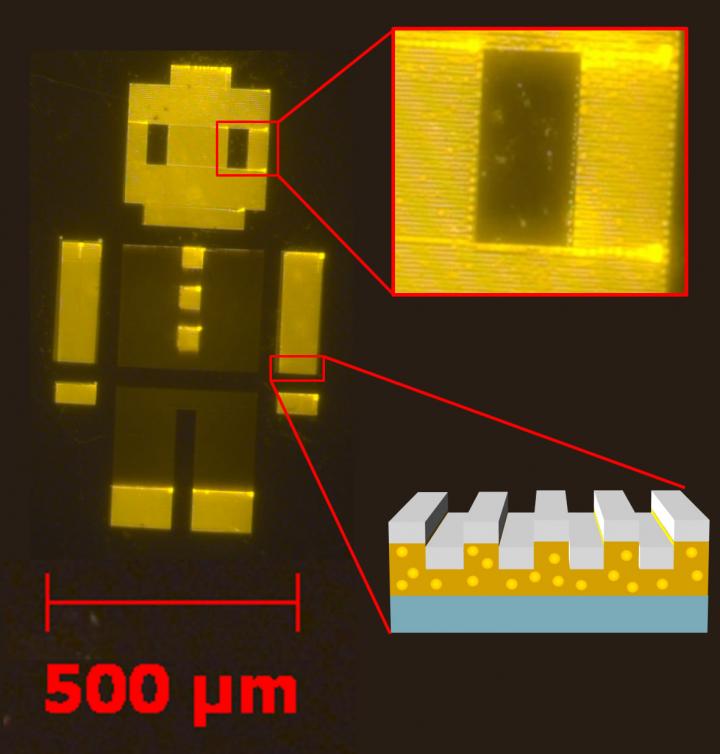New research may enhance display & LED lighting technology

To demonstrate their new technology, researchers fabricated a novel 1mm device (aka Robot Man) made of yellow photonic-crystal-enhanced QDs. Every region of the device has thousands of quantum dots, each measuring about six nanometers. Credit: Gloria See, University of Illinois at Urbana-Champaign
Recently, quantum dots (QDs)–nano-sized semiconductor particles that produce bright, sharp, color light–have moved from the research lab into commercial products like high-end TVs, e-readers, laptops, and even some LED lighting. However, QDs are expensive to make so there's a push to improve their performance and efficiency, while lowering their fabrication costs.
Researchers from the University of Illinois at Urbana-Champaign have produced some promising results toward that goal, developing a new method to extract more efficient and polarized light from quantum dots (QDs) over a large-scale area. Their method, which combines QD and photonic crystal technology, could lead to brighter and more efficient mobile phone, tablet, and computer displays, as well as enhanced LED lighting.
With funding from the Dow Chemical Company, the research team, led by Electrical & Computer Engineering (ECE) Professor Brian Cunningham, Chemistry Professor Ralph Nuzzo, and Mechanical Science & Engineering Professor Andrew Alleyne, embedded QDs in novel polymer materials that retain strong quantum efficiency. They then used electrohydrodynamic jet (e-jet) printing technology to precisely print the QD-embedded polymers onto photonic crystal structures. This precision eliminates wasted QDs, which are expensive to make.
These photonic crystals limit the direction that the QD-generated light is emitted, meaning they produce polarized light, which is more intense than normal QD light output.
According to Gloria See, an ECE graduate student and lead author of the research reported this week in Applied Physics Letters, their replica molded photonic crystals could someday lead to brighter, less expensive, and more efficient displays. “Since screens consume large amounts of energy in devices like laptops, phones, and tablets, our approach could have a huge impact on energy consumption and battery life,” she noted.
“If you start with polarized light, then you double your optical efficiency,” See explained. “If you put the photonic-crystal-enhanced quantum dot into a device like a phone or computer, then the battery will last much longer because the display would only draw half as much power as conventional displays.”
To demonstrate the technology, See fabricated a novel 1mm device (aka Robot Man) made of yellow photonic-crystal-enhanced QDs. The device is made of thousands of quantum dots, each measuring about six nanometers.
“We made a tiny device, but the process can easily be scaled up to large flexible plastic sheets,” See said. “We make one expensive 'master' molding template that must be designed very precisely, but we can use the template to produce thousands of replicas very quickly and cheaply.”
###
Other members of the Illinois research team include graduate student Lu Xu (chemistry, who performed the polymer-QD mixing, and graduate student Erick Sutanto (MechSE), who performed the e-jet printing.
Media Contact
All latest news from the category: Power and Electrical Engineering
This topic covers issues related to energy generation, conversion, transportation and consumption and how the industry is addressing the challenge of energy efficiency in general.
innovations-report provides in-depth and informative reports and articles on subjects ranging from wind energy, fuel cell technology, solar energy, geothermal energy, petroleum, gas, nuclear engineering, alternative energy and energy efficiency to fusion, hydrogen and superconductor technologies.
Newest articles

Trotting robots reveal emergence of animal gait transitions
A four-legged robot trained with machine learning by EPFL researchers has learned to avoid falls by spontaneously switching between walking, trotting, and pronking – a milestone for roboticists as well…

Innovation promises to prevent power pole-top fires
Engineers in Australia have found a new way to make power-pole insulators resistant to fire and electrical sparking, promising to prevent dangerous pole-top fires and reduce blackouts. Pole-top fires pose…

Possible alternative to antibiotics produced by bacteria
Antibacterial substance from staphylococci discovered with new mechanism of action against natural competitors. Many bacteria produce substances to gain an advantage over competitors in their highly competitive natural environment. Researchers…





















